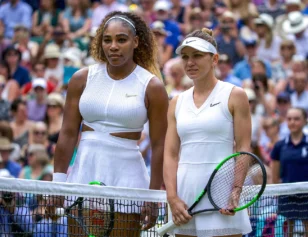Serena.
No last name is needed when discussing arguably the greatest women’s singles tennis player of all time. She is simply, Serena.
But there is nothing simple about Serena. Not her upbringing. Not how she learned the game of tennis. Not in the way she is still.
She’s 32. Most female tennis players her age would have retired by now. The wear and tear of running, stopping, starting, turning, sliding, hitting, serving and that’s just the physical side of the sport. The training, the travel, the mental side; oh, the mental side.
If’s just you versus your opponent. Out on the court. Some with bright lights and huge crowds. Some, quiet and empty. The support system is around, but they may as well be in another city. The court is a solitary place. Alone with thoughts. Thoughts of strategy, of wins and losses past.
What’s working, what’s not? Is my toss too high? Take the ball earlier. Move your feet. Stop hitting to the backhand. Follow-through. Anticipate the drop. How much is the wind blowing? I need more water. I need a trainer. No, no, no. Stop thinking those things.
YOU CAN DO THIS!
**
(Photo credit: Julian Finney/Getty Images)
Solitary is not simple. Not when it comes to tennis. And not when it comes to Serena.
Tonight, Serena will embark on what could be the most challenging tournament in her career. Not because of the tournament itself. No, she’s won this tournament, the U.S. Open, six times. This time, the mental side gets even tougher. History, magnified, has entered the scene.
Winning a Grand Slam tournament is never easy. A wee bit of luck and a whole lot of skill go into a GS victory. Serena has done it 21 times prior. But, this time…this time she’s striving for something that hasn’t been done since 1988.
**
1988 was the year of Steffi. Well, truth be told, more often than not she was simply Graf. Graf won this. Graf did that. Graf with that wicked forehand. Fraulein Forehand, as longtime tennis journalist Bud Collins called her. She was stoic and far different than the Martina Navratilova and Chris Evert casual fans were used to. As Louisa Thomas stated in her recent Grantland piece, She won simply, without drama. She was brilliant without being blazing. She was merely the best.
And she was the best.
Then Monica Seles happened. And then the incident happened and then Seles was gone. Oh she returned, but she was never the same player. The player that not only could, but would, compete and defeat Graf. That would come later. 1988 was golden.
Graf’s year was colored with Australian, French, Wimbledon, U.S. Open and Olympic titles. She was dominant. But she was German. In the midst of the cold war, casual U.S. fans found it hard to embrace this champion. Even though she was from West Germany, she was still German.
She didn’t say much she didn’t have to. Her play and racket, did all the talking for her. Many fans did not cheer for her outwardly. Underdogs Americans cheer for underdogs. Fans of various countries cheer for underdogs. Fans wanted to see her lose, see her upset. That often happens when one is as dominant as Graf.
The fans weren’t on her side. She was solitary in her pursuit. Solitary in trying grasp the situation. Solitary in her pursuit.
YOU CAN DO THIS!
**
The scrutiny on Serena is at an all-time high. Some who weren’t around to witness Graf’s great achievement want to see history. Americans, for as much as they like cheering for the underdog, also crave to see history.
At this year’s U.S. Open, the women’s final sold out before the men’s final for the first time in history, according to multiple reports. History has a way of moving wallets and eyeballs. And, in today’s society, Twitter mentions.
According to Topsy.com, in the past 30 days:
Serena has been mentioned in over 381k tweets
Serena Williams has been mentioned in over 158k tweets
That number will rise today, tomorrow and for as long as Serena remains in the tournament. History is driving the conversation for a number of reasons, some of which has been discussed here and here.
In tennis, no two matches are the same. Even if Serena has faced and beaten an opponent before, it’s still a new tournament, a new day and a new mental challenge. Seven matches to history. Seven matches of solitude. Seven matches of fighting the pressure.
As Serena has stated many times, she puts more pressure on herself than others do. At age 33, she’s been through all kinds of pressure in tennis and in life. But, in tennis terms, Serena’s never had to deal with chasing history like this.
As the saying goes, the target is on her back. Opponents will bring their best effort, and they’re not just the faces waiting on the other side of the net for her serve. They’ll be doing their own mental gymnastics like Serena.
Can I beat her? Get your first serve in. Switch up your shots. Don’t play afraid. What shot was it that worked in our last match? How did _____ beat her? Focus on you. One point at a time. Why did you try that shot? No, no, no. Stop thinking those things
YOU CAN DO THIS!
**
From race to Compton to money and more, there has been no shortage of stories on Serena as this tennis year has unfolded. With each win, the conversations increase. She has her doubters some would call them haters. She has her fans, some of the most loyal of any athlete. Each brings their own perspective and view on her as both an athlete and a person. Some conversations are productive. Some, like those of the 140-character kind, are not.
How this U.S. Open plays out for Serena will be a fascinating watch in itself. Watching the reaction to each Serena match play out on Twitter and other social networks and blogs could be otherworldly.
No one’s going to beat her. Why did she hit that shot? Best serve ever. The ball was in! Challenge the shot, Serena. Turn it on, Serena. Come on, Serena, focus! I want her to win so bad! She’s the best! She’s an inspiration to girls everywhere. Is that linesman blind?? Oh my gosh, MATCH POINT!
YOU CAN DO THIS, SERENA!




